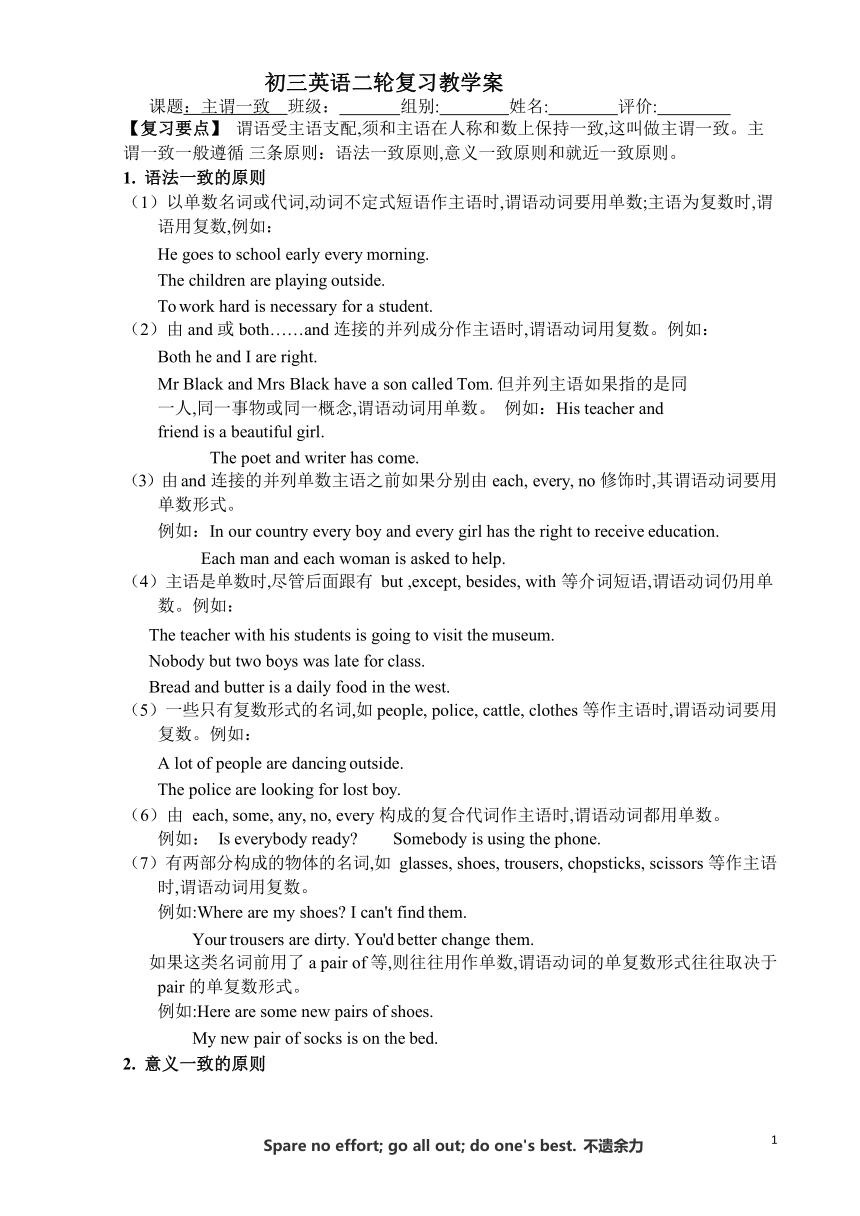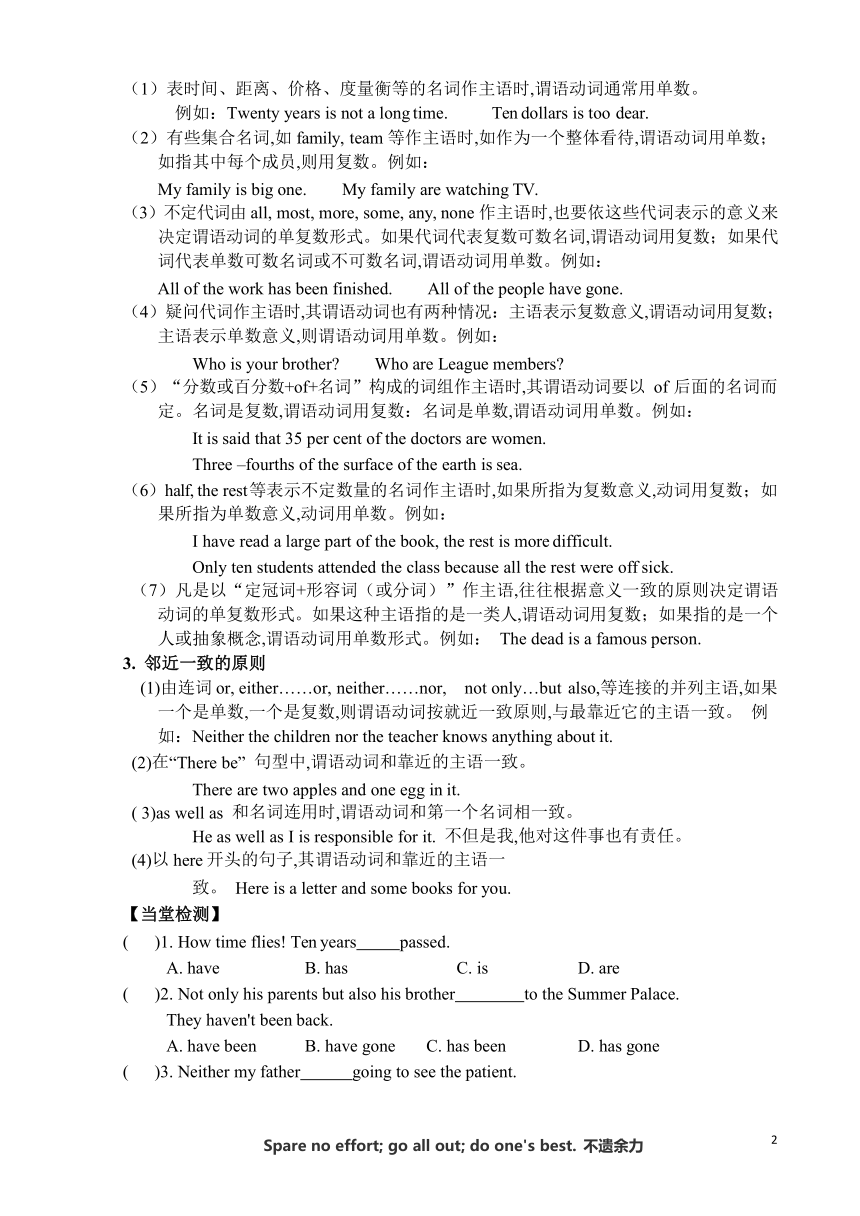2023中考二轮专项复习-主谓一致(无答案)
文档属性
| 名称 | 2023中考二轮专项复习-主谓一致(无答案) |  | |
| 格式 | docx | ||
| 文件大小 | 16.0KB | ||
| 资源类型 | 教案 | ||
| 版本资源 | 通用版 | ||
| 科目 | 英语 | ||
| 更新时间 | 2023-05-22 13:22:13 | ||
图片预览


文档简介
初三英语二轮复习教学案
课题:主谓一致 班级: 组别: 姓名: 评价:
【复习要点】 谓语受主语支配,须和主语在人称和数上保持一致,这叫做主谓一致。主谓一致一般遵循 三条原则:语法一致原则,意义一致原则和就近一致原则。
1. 语法一致的原则
(1)以单数名词或代词,动词不定式短语作主语时,谓语动词要用单数;主语为复数时,谓 语用复数,例如:
He goes to school early every morning. The children are playing outside.
To work hard is necessary for a student.
(2)由 and 或 both……and 连接的并列成分作主语时,谓语动词用复数。例如:
Both he and I are right.
Mr Black and Mrs Black have a son called Tom. 但并列主语如果指的是同一人,同一事物或同一概念,谓语动词用单数。 例如:His teacher and friend is a beautiful girl.
The poet and writer has come.
(3)由 and 连接的并列单数主语之前如果分别由 each, every, no 修饰时,其谓语动词要用 单数形式。
例如:In our country every boy and every girl has the right to receive education.
Each man and each woman is asked to help.
(4)主语是单数时,尽管后面跟有 but ,except, besides, with 等介词短语,谓语动词仍用单 数。例如:
The teacher with his students is going to visit the museum. Nobody but two boys was late for class.
Bread and butter is a daily food in the west.
(5)一些只有复数形式的名词,如 people, police, cattle, clothes 等作主语时,谓语动词要用 复数。例如:
A lot of people are dancing outside. The police are looking for lost boy.
(6)由 each, some, any, no, every 构成的复合代词作主语时,谓语动词都用单数。
例如: Is everybody ready Somebody is using the phone.
(7)有两部分构成的物体的名词,如 glasses, shoes, trousers, chopsticks, scissors 等作主语 时,谓语动词用复数。
例如:Where are my shoes I can't find them.
Your trousers are dirty. You'd better change them.
如果这类名词前用了 a pair of 等,则往往用作单数,谓语动词的单复数形式往往取决于
pair 的单复数形式。
例如:Here are some new pairs of shoes. My new pair of socks is on the bed.
2. 意义一致的原则
(
1
) (
Spare no effort; go all out; do one's best.
不遗余力
)
(1)表时间、距离、价格、度量衡等的名词作主语时,谓语动词通常用单数。 例如:Twenty years is not a long time. Ten dollars is too dear.
(2)有些集合名词,如 family, team 等作主语时,如作为一个整体看待,谓语动词用单数; 如指其中每个成员,则用复数。例如:
My family is big one. My family are watching TV.
(3)不定代词由 all, most, more, some, any, none 作主语时,也要依这些代词表示的意义来 决定谓语动词的单复数形式。如果代词代表复数可数名词,谓语动词用复数;如果代 词代表单数可数名词或不可数名词,谓语动词用单数。例如:
All of the work has been finished. All of the people have gone.
(4)疑问代词作主语时,其谓语动词也有两种情况:主语表示复数意义,谓语动词用复数; 主语表示单数意义,则谓语动词用单数。例如:
Who is your brother Who are League members
(5)“分数或百分数+of+名词”构成的词组作主语时,其谓语动词要以 of 后面的名词而 定。名词是复数,谓语动词用复数:名词是单数,谓语动词用单数。例如:
It is said that 35 per cent of the doctors are women. Three –fourths of the surface of the earth is sea.
(6)half, the rest 等表示不定数量的名词作主语时,如果所指为复数意义,动词用复数;如
果所指为单数意义,动词用单数。例如:
I have read a large part of the book, the rest is more difficult.
Only ten students attended the class because all the rest were off sick.
(7)凡是以“定冠词+形容词(或分词)”作主语,往往根据意义一致的原则决定谓语 动词的单复数形式。如果这种主语指的是一类人,谓语动词用复数;如果指的是一个 人或抽象概念,谓语动词用单数形式。例如: The dead is a famous person.
3. 邻近一致的原则
(1)由连词 or, either……or, neither……nor, not only…but also,等连接的并列主语,如果 一个是单数,一个是复数,则谓语动词按就近一致原则,与最靠近它的主语一致。 例如:Neither the children nor the teacher knows anything about it.
(2)在“There be” 句型中,谓语动词和靠近的主语一致。
There are two apples and one egg in it.
( 3)as well as 和名词连用时,谓语动词和第一个名词相一致。
He as well as I is responsible for it. 不但是我,他对这件事也有责任。
(4)以here开头的句子,其谓语动词和靠近的主语一致。 Here is a letter and some books for you.
【当堂检测】
( )1. How time flies! Ten years passed.
A. have B. has C. is D. are
( )2. Not only his parents but also his brother to the Summer Palace.
They haven't been back.
A. have been B. have gone C. has been D. has gone ( )3. Neither my father going to see the patient.
A. nor I am B. nor I are C. or me are D. or me is ( )4. Look! There playing with the tourists on Yinhe Square.
A. are a number of deer B. are a number of deers
C. is a number of deer D. is a number of deers
( )5. A meal including meat, vegetables and fruit _ good to our health.
A. does B. do C. doing D. are
【当堂检测】
( )1. They said the eighteenth and last lesson _ quite easy.
A. is B. was C. were D. are ( )2. My shirt white and my trousers blue.
A. are, are B. are, is C. is, are D. is, is ( )3. Our knowledge of computer growing all the time.
A. be B. is C.are D. was
( )4. Everyone except Tom and John there when the meeting began.
A. is B. was C. were D. are ( )5. A large number of students to work in Xinjiang.
A. have gone B. has gone C. goes D. go ( )6. There a lot of good news in today's newspaper.
A. is B. are C. was D. were ( )7. Half of the apples good.
A. is B. are C. was D. were ( )8. Mary as well as her sisters Chinese in China.
A. are studying B. have studied C. studies D. study ( )9. Tom with other boys to go and the game.
want, watch B. wants, watches C. wants, watch D. want, to watch ( )10. ---There _ a pair of shoes under the bed. –-- The shoes mine.
is, are B. is, is C. are, is D. are, are
( )11. Three hours quite a long time for the students to play computer games every day.
A. is B. were C. was D. are
( )12. The number of the students in our class _ large.
A. is B. are C. has D. have
( ) 13.A number of my friends me presents for Christmas every year.
A. gives B. give C. gave D. giving
(
4
) (
Spare no effort; go all out; do one's best.
不遗余力
)
课题:主谓一致 班级: 组别: 姓名: 评价:
【复习要点】 谓语受主语支配,须和主语在人称和数上保持一致,这叫做主谓一致。主谓一致一般遵循 三条原则:语法一致原则,意义一致原则和就近一致原则。
1. 语法一致的原则
(1)以单数名词或代词,动词不定式短语作主语时,谓语动词要用单数;主语为复数时,谓 语用复数,例如:
He goes to school early every morning. The children are playing outside.
To work hard is necessary for a student.
(2)由 and 或 both……and 连接的并列成分作主语时,谓语动词用复数。例如:
Both he and I are right.
Mr Black and Mrs Black have a son called Tom. 但并列主语如果指的是同一人,同一事物或同一概念,谓语动词用单数。 例如:His teacher and friend is a beautiful girl.
The poet and writer has come.
(3)由 and 连接的并列单数主语之前如果分别由 each, every, no 修饰时,其谓语动词要用 单数形式。
例如:In our country every boy and every girl has the right to receive education.
Each man and each woman is asked to help.
(4)主语是单数时,尽管后面跟有 but ,except, besides, with 等介词短语,谓语动词仍用单 数。例如:
The teacher with his students is going to visit the museum. Nobody but two boys was late for class.
Bread and butter is a daily food in the west.
(5)一些只有复数形式的名词,如 people, police, cattle, clothes 等作主语时,谓语动词要用 复数。例如:
A lot of people are dancing outside. The police are looking for lost boy.
(6)由 each, some, any, no, every 构成的复合代词作主语时,谓语动词都用单数。
例如: Is everybody ready Somebody is using the phone.
(7)有两部分构成的物体的名词,如 glasses, shoes, trousers, chopsticks, scissors 等作主语 时,谓语动词用复数。
例如:Where are my shoes I can't find them.
Your trousers are dirty. You'd better change them.
如果这类名词前用了 a pair of 等,则往往用作单数,谓语动词的单复数形式往往取决于
pair 的单复数形式。
例如:Here are some new pairs of shoes. My new pair of socks is on the bed.
2. 意义一致的原则
(
1
) (
Spare no effort; go all out; do one's best.
不遗余力
)
(1)表时间、距离、价格、度量衡等的名词作主语时,谓语动词通常用单数。 例如:Twenty years is not a long time. Ten dollars is too dear.
(2)有些集合名词,如 family, team 等作主语时,如作为一个整体看待,谓语动词用单数; 如指其中每个成员,则用复数。例如:
My family is big one. My family are watching TV.
(3)不定代词由 all, most, more, some, any, none 作主语时,也要依这些代词表示的意义来 决定谓语动词的单复数形式。如果代词代表复数可数名词,谓语动词用复数;如果代 词代表单数可数名词或不可数名词,谓语动词用单数。例如:
All of the work has been finished. All of the people have gone.
(4)疑问代词作主语时,其谓语动词也有两种情况:主语表示复数意义,谓语动词用复数; 主语表示单数意义,则谓语动词用单数。例如:
Who is your brother Who are League members
(5)“分数或百分数+of+名词”构成的词组作主语时,其谓语动词要以 of 后面的名词而 定。名词是复数,谓语动词用复数:名词是单数,谓语动词用单数。例如:
It is said that 35 per cent of the doctors are women. Three –fourths of the surface of the earth is sea.
(6)half, the rest 等表示不定数量的名词作主语时,如果所指为复数意义,动词用复数;如
果所指为单数意义,动词用单数。例如:
I have read a large part of the book, the rest is more difficult.
Only ten students attended the class because all the rest were off sick.
(7)凡是以“定冠词+形容词(或分词)”作主语,往往根据意义一致的原则决定谓语 动词的单复数形式。如果这种主语指的是一类人,谓语动词用复数;如果指的是一个 人或抽象概念,谓语动词用单数形式。例如: The dead is a famous person.
3. 邻近一致的原则
(1)由连词 or, either……or, neither……nor, not only…but also,等连接的并列主语,如果 一个是单数,一个是复数,则谓语动词按就近一致原则,与最靠近它的主语一致。 例如:Neither the children nor the teacher knows anything about it.
(2)在“There be” 句型中,谓语动词和靠近的主语一致。
There are two apples and one egg in it.
( 3)as well as 和名词连用时,谓语动词和第一个名词相一致。
He as well as I is responsible for it. 不但是我,他对这件事也有责任。
(4)以here开头的句子,其谓语动词和靠近的主语一致。 Here is a letter and some books for you.
【当堂检测】
( )1. How time flies! Ten years passed.
A. have B. has C. is D. are
( )2. Not only his parents but also his brother to the Summer Palace.
They haven't been back.
A. have been B. have gone C. has been D. has gone ( )3. Neither my father going to see the patient.
A. nor I am B. nor I are C. or me are D. or me is ( )4. Look! There playing with the tourists on Yinhe Square.
A. are a number of deer B. are a number of deers
C. is a number of deer D. is a number of deers
( )5. A meal including meat, vegetables and fruit _ good to our health.
A. does B. do C. doing D. are
【当堂检测】
( )1. They said the eighteenth and last lesson _ quite easy.
A. is B. was C. were D. are ( )2. My shirt white and my trousers blue.
A. are, are B. are, is C. is, are D. is, is ( )3. Our knowledge of computer growing all the time.
A. be B. is C.are D. was
( )4. Everyone except Tom and John there when the meeting began.
A. is B. was C. were D. are ( )5. A large number of students to work in Xinjiang.
A. have gone B. has gone C. goes D. go ( )6. There a lot of good news in today's newspaper.
A. is B. are C. was D. were ( )7. Half of the apples good.
A. is B. are C. was D. were ( )8. Mary as well as her sisters Chinese in China.
A. are studying B. have studied C. studies D. study ( )9. Tom with other boys to go and the game.
want, watch B. wants, watches C. wants, watch D. want, to watch ( )10. ---There _ a pair of shoes under the bed. –-- The shoes mine.
is, are B. is, is C. are, is D. are, are
( )11. Three hours quite a long time for the students to play computer games every day.
A. is B. were C. was D. are
( )12. The number of the students in our class _ large.
A. is B. are C. has D. have
( ) 13.A number of my friends me presents for Christmas every year.
A. gives B. give C. gave D. giving
(
4
) (
Spare no effort; go all out; do one's best.
不遗余力
)
同课章节目录
- 词法
- 名词
- 动词和动词短语
- 动词语态
- 动词时态
- 助动词和情态动词
- 非谓语动词
- 冠词
- 代词
- 数词和量词
- 形容词副词及其比较等级
- 介词和介词短语
- 连词和感叹词
- 构词法
- 相似、相近词比较
- 句法
- 陈述句
- 一般疑问句和否定疑问句
- 特殊疑问句及选择疑问句
- 反意疑问句
- 存在句(There be句型)
- 宾语从句
- 定语从句
- 状语从句
- 主谓一致问题
- 简单句
- 并列句
- 复合句
- 主谓一致
- 主、表语从句
- 名词性从句
- 直接引语和间接引语
- 虚拟语气
- 感叹句
- 强调句
- 倒装句
- 祈使句
- 句子的成分
- 句子的分类
- 题型专区
- 单项选择部分
- 易错题
- 完形填空
- 阅读理解
- 词汇练习
- 听说训练
- 句型转换
- 补全对话
- 短文改错
- 翻译
- 书面表达
- 任务型阅读
- 语法填空
- 其他资料
